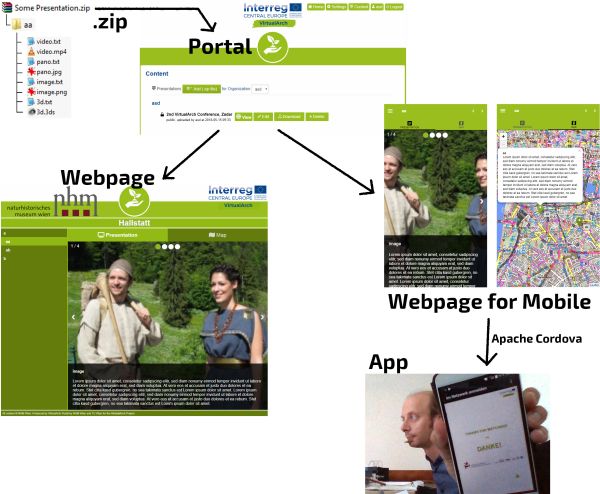Gabriel WURZER1 | Hans RESCHREITER2 | Fiona POPPENWIMMER2 | Jiri UNGER3 | Christoph LOBINGER4 | Christiane HEMKER4
(1Technische Universität Wien | 2Naturhistorisches Museum Wien, Vienna Austria | 3Czech Academy of Sciences Prague, Czech Republic | 4Landesamt für Archäologie Sachsen, Dresden, Germany)
Keywords: Location-based cellphone apps; app production; web technologies
Abstract:
The technical divide between app producers and archaeologists has led to a situation in which publication of heritage on mobile devices is hindered by lack of funding: Programming an app is expensive; keeping the content up to date furthermore requires regular updates which add up to the running costs.
In our work for the EU Project VirtualArch, we have thus sought a way in which archaologists can cross this technical barrier and produce a location-based App without need for programming or external consultancy.
In more detail, we have produced a portal which allows the upload of a zip file containing a range of media (images, text, 3D files, panoramas, movies) in one or more folders; each one is transformed into a points of interest on a map for which the associated media can be shown as a slideshow. The key strength of the approach lies in the fact that the portal can produce both web presentations as well as apps using the same content. Technically this is achieved via the use of rules for transforming the content into html/css + javascript, and Apache Cordova / Adobe PhoneGap for turning the resulting web page into an app.
Since archaeologists are perfectly capable of producing content, they can now disseminate their work frequently to a wider public, without being hindered by technological and/or financial barriers. Our portal is open-source, allowing a wide range of disciplines who are occupied with location-based presentations (e.g. also tourist offices, festivals etc.) to benefit from our proposed approach.
Relevance for the conference: This contribution enables to produce a location-based heritage app without needing to program
Relevance for the session: We present a “from zip to app”-workflow as a main contribution and discussion point among the session
Innovation: Transforms a folder + file hierarchy into a location-based app
References:
• E Dobat, S Walkshofer & C Flügel (2013): ‘Mainlimes Mobil: Presenting Archaeology and Museums with the Help of Smartphones’, in Nigel Mills (Ed.), ‘ Presenting the Romans: Interpreting the Frontiers of the Roman Empire World Heritage Site’, Heritage Matters 12, Boydell & Brewer and Boydell Press, pp. 103-112. see online: https://www.jstor.org/stable/10.7722/j.ctt31nhq2
• H Von Seggern (2017, in press): ‘ Museum 4.0: On the use and abuse of mobile digital devices in museums and archaeological sites’, in Proceedings of CHNT 2017, abstract available online: http://archiv.chnt.at/museum-4-0-on-the-use-and-abuse-of-mobile-digital-devices-in-museums-and-archaeological-sites/



